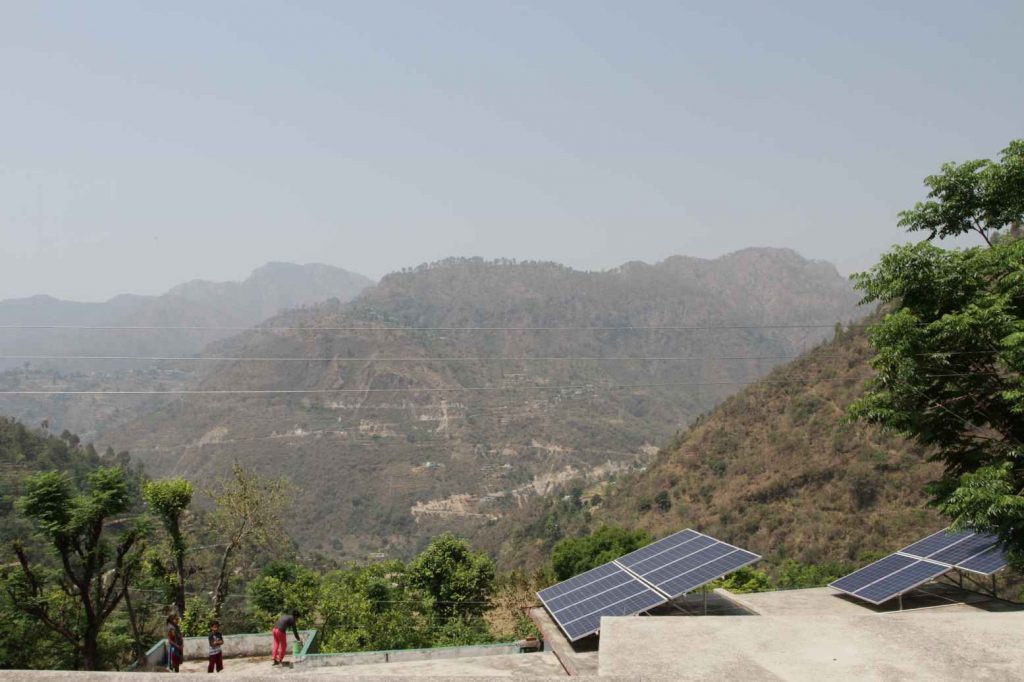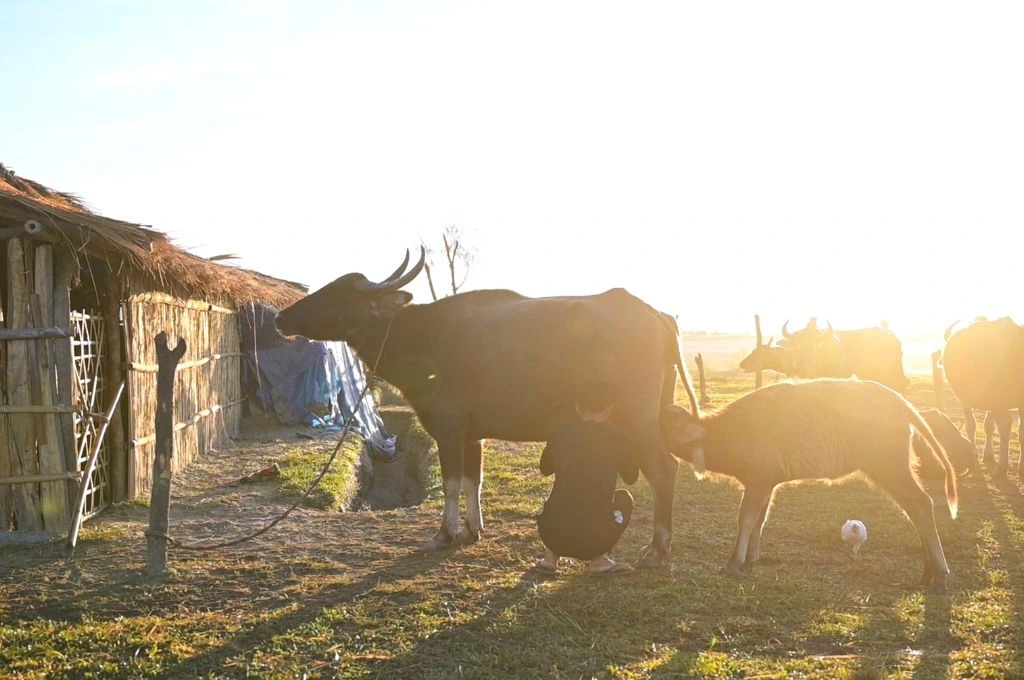In October 2020, Uttarakhand Chief Minister Trivendra Singh Rawat launched the Mukhya Mantri Saur Swarojgar Yojana (Chief Minister’s Solar Self-Employment Scheme). An ambitious energy development plan, the scheme aims to construct 10,000 small-scale solar plants by March 31st, 2022, each 25 kilowatts (kW) in size. This is expected to add 250 megawatts (MW) to the state’s total solar capacity and have a significant impact on the energy mix of Uttarakhand. As of December 31st, 2020, renewable energy sources (RES)—which include small-scale hydro, biogas, biomass, waste, wind, and solar—generated a total of 664.98MW (or 18 percent of the state’s total power). This makes RES the third-largest source of power in Uttarakhand, after hydro (1975.89MW or 54 percent), and all thermal or fossil fuel sources (980.83MW or 27 percent).
However, beyond boosting solar power generation, the main goal of the scheme is to offer a source of financial support or ‘self-employment’ to those whose livelihoods have been impacted by the COVID-19 pandemic. The people this plan aims to serve are the unemployed youth, low-income residents, and migrant workers who have had to leave their jobs in other parts of the country. Prospective participants can apply to own one of the new installations and then sell energy back to the grid. The expectation is that each solar plant will generate 38,000 units of electricity each year. For a contracted period of 25 years, the Uttarakhand Power Corporation Limited will buy the electricity for a fixed price (INR 3.14 per kilowatt-hour), according to tariffs set by the Uttarakhand Electricity Regulatory Commission.
While the scale of the scheme is unprecedented, this is not Uttarakhand’s first plan to combine solar generation with increasing marginal incomes. Aligned with the national government’s pledge to double farmers’ incomes by 2022, a previous programme—the ‘Power Farmers’ scheme—attempted to make Annadaata (food provider) into Urja-daata (energy provider). What can past experiences tell us about the anticipated effectiveness and long-term sustainability of the new solar self-employment scheme?

Insights from past solar self-employment schemes
Announced in November 2016 by the Uttarakhand Renewable Energy Development Agency (UREDA), the ‘Power Farmers’ initiative, allowed households across the state’s 11 designated hilly districts to apply for support to construct a grid-connected, rooftop solar power plant (usually 4kW) on their property. By 2018, there were more than 2,000 households participating in this initiative, also known as Suryodaya Swarojgar Yojana (Sunrise Self- Employment Scheme). My research on the Power Farmers programme highlights a number of key issues that are likely to impact the new ‘solar farmer’ initiative as well:
Inequalities in programme access
Families with better social connections (people who could advise on when and how to submit application forms) and formal education had better chances to apply for the programme.
Long-term sustainability
The limited involvement of UREDA (first five years of operations) meant that post that period, households would be responsible for potentially very expensive maintenance work and costs.
Grid stability
Small-scale solar plants encounter numerous technical setbacks, especially in more outlying areas. These include fluctuation in grid voltage, regular outage in the grid line, and regular tripping of inverter fuses—all of which limit generation potential.

Rooftop solar in India has attracted major government investments as well as international interest, with the World Bank allocating almost a billion dollars for grid-connected rooftop solar photovoltaic in India since 2016. However, across the country, the uptake of rooftop solar has been slower than expected. This is due to a combination of factors including mistrust, lack of finance, and complex institutional procedures—with Uttarakhand ranking around the middle of nationwide comparisons for solar capacity additions. It remains vital that future energy initiatives build on prior successes while learning from past mistakes.

Does the new scheme address these issues?
An analysis of the current scheme suggests that issues of access and land use change have received more attention than grid instability and longer-term viability.
1. Improving access
The rural livelihoods sector faces persistent challenges due to inequality, lack of investment capital, low literacy skills, and inadequate information provision to target communities. While launching the current solar scheme, state officials hoped to address two of these barriers—regarding information and literacy. They confirmed that there would be annual and district-based participation drives and no educational requirements that need to be met by applicants.
There is a mismatch between the fixed power purchase agreement rates and the increasing interest burden of new loans.
The scheme also aims to aid participation with financing options. The target demographic—unemployed young people and migrant workers—usually do not maintain large landholdings. To overcome this, participants without the quoted 1.5-2 nalis (480 square yards) sufficient to house each 25kW solar power plant, will be eligible for loans from select banks at an interest rate of 8 percent per annum for 15 years. While this might aid participation, there is a mismatch here between the fixed power purchase agreement rates and the increasing interest burden of new loans. The 25-year electricity tariff rate paid to solar power farmers (INR 3.14 per kilowatt-hour) is set (and subject to review) by the state Electricity Regulatory Commission, and this figure is unlikely to rise significantly. As solar capacity continues to grow, this rate could even decrease. This means that participants are unlikely to be able to make loan repayments from the sale of electricity alone.
2. Ensuring long-term sustainability
There is no clarity on whose responsibility it would be to ensure that all 10,000 solar plants remain productive for the 25-year contract period. Bids from installation companies closed on November 30th, 2020, with the total cost for each 25kW plant set to a maximum of INR 10 lakh (approximately USD 13,526). Yet, it is uncertain whether the companies taking up these contracts will supply ongoing maintenance support, be active across all participating regions in Uttarakhand, and if they will guarantee technical assistance for the life-span of each solar installation.
3. Grid stability is still a concern
The scheme announcements do not address grid instability. This is an issue that had negatively impacted the Power Farmers programme and is something that many project participants interviewed in my research raised as a complaint. The current grid infrastructure frequently failed to accommodate the extra generation capacity (approximately 8MW total) from the 2,000 Power Farmers solar plants. The new scheme’s capacity is much larger at 250MW. Therefore, any new energy initiative designed for Uttarakhand’s outlying areas should have significant grid improvements and improved investment to ensure its full potential and capacity is utilised.
4. Integrating food and energy production
There are concerns globally that ongoing growth in solar generation will lead to land conflicts and dispossession of agropastoralists’ land by state agencies and energy companies, particularly in highly agriculture-focused economies such as India. On this issue, the current scheme aims to promote a combined approach to energy and food production.
It is important to recognise similarities with the earlier Power Farmers programme and to ensure that previous shortcomings are not replicated.
While launching the scheme, State Energy Department Secretary, Radhika Jha, emphasised plans for integrated farming. Now, there is a provision for the plantation and production of fruits, vegetables, and herbs, on the same land as the solar panels. For this, the scheme participants can avail crop seeds free of cost. In the short term, income from selling solar energy might be more reliable than selling food, due to a guaranteed rate to buffer against market-price fluctuations. However, the long-term effectiveness of such combined ‘agrivoltaics’ approaches to food and energy production remains to be seen, especially with regard to their impacts on local hydrology, plant health, and overall productivity.
As attention globally begins to turn toward a post-COVID-19 world, including in Uttarakhand, renewable energy consistently occupies a central position in visions for ‘innovation’ and what comes next. The recent Solar Self-Employment Scheme may appear novel—especially since it is targeting those adversely affected by the ongoing COVID-19 pandemic. However, it is important to recognise similarities with the earlier Power Farmers programme and to ensure that previous shortcomings are not replicated. For example, on the issue of grid instability, each new energy initiative only highlights the state-wide need for increased electricity grid investment and infrastructure improvements. Such lessons need to be learned if ‘solar self-employment’ is to have an effective future in helping to stabilise the living situations of poor and marginalised people across Uttarakhand and India, particularly under conditions of pandemic and recovery.
—
Know more
- Read more about the ‘paradox’ of India’s energy transition.
- Learn more about environmental justice movements in India and around the world and their importance for understanding energy issues, including movements within Uttarakhand.
- Explore the shifting global context for energy development in India.




